One of the main perks of being in NYC is the vast number of galleries and museums that we can visit and take advantage of. An avid museum goer myself, exploring the various museums around the city exposed me to a the finest in art, from classical to cutting edge. Some of the galleries we visited as part of our Cornell AAP NYC program and others on our own. Here is a list of some of the finest museums and galleries;
1. The Whitney Museum
As part of our Theory of Architecture elective, Bordering, taught by Cornell Alumnus Sean Anderson (B.Arch./B.S. ’96), many of us visited the Whitney Museum during the Whitney Biennial as part of our first assignment. As the preeminent institution devoted to the art of the United States, the Whitney Museum of American Art presents the full range of twentieth century and contemporary American art, with a special focus on works by living artists. This year’s biennial, brought to focus many social questions prevalent today in which, artists are responding to the conditions of living in a country with increasing social stratifications and are forced to reexamine their own estrangement from broader culture.
2. LMCC’s Arts Center at Governors Island
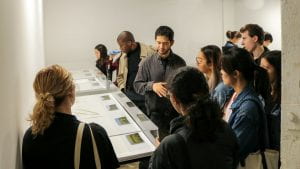


We also visited LMCC’s (Lower Manhattan Cultural Council) Arts Center at Governors Island on a field trip during our class. The center features artists residency programs with studios and spaces for artists to develop their work as well as a broad range of events for artists and the public to convene and exchange ideas and creative practices.
This year the themes of the exhibit was featured on ecology, sustainability and resilience. During our visit, we had the opportunity to meet Michael Wang and see his work titled, Extinct in New York. He spoke to us about his research and investigation into the boundaries of nature, nurture and human intervention. Over the past several months, he had nurtured a selection of species known historically from NYC that no longer exists in the wild. His research culminated into a site-specific installation with the LMCC in which these young plants were exhibited within a series of greenhouses. The exhibition space becomes an incubator for species that otherwise no longer have a home in the city. As part of the work, these plants are cared for daily by volunteers.
3. Grey Art Gallery, New York University
We also visited the Grey Art Gallery at New York University, a fine art museum that functions to collect, preserve, study, document and exhibit the evidence of human culture. We visited the exhibit on Modernisms: Iran, Turkish, and Indian Highlights from NYU’s Abby Weed Grey Collection. The exhibit was the very first to combine paintings, sculptures, prints and drawings from the 1960s and early 1970s from Iran, Turkey and India. The exhibit highlights how artists drew inspiration from their respective heritage and engaged in discourses of modernity.
4. Arthur Ross Architecture Gallery, Buell Hall, Columbia University

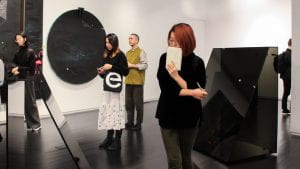
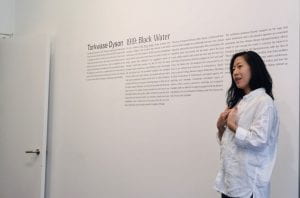
Just recently we had the opportunity to travel all the way uptown to visit Arthur Ross Gallery at Columbia University. There we had the amazing opportunity to see the exhibition 1919: Black Water, a solo exhibition of new work by Torkwase Dyson. We got to meet and speak with by Irene Sunwoo, GSAPP Director of Exhibitions and Curator gallery. The gallery tries to break away from what is traditionally considered as an architectural gallery and seeks to offer new ways of perceiving, interpreting and interacting with architecture and the world around us.
There she spoke to us on the process with which 1919:Black Water was created. The work was created in the gallery itself. The gallery functioned as a studio for the artist over a period of two months where she both prepared and conceptualized her work for the exhibition. The work combines expressive mark making and geometric abstraction by which the artist created visual and material systems that explored relationships between bodily movement and architecture.
5. The Modern Museum of Art
We also visited the Modern Museum of Art (MOMA), as mentioned in an earlier blog post, after it newly opened after 5 months of closure. The “new” MOMA as we see it today has opened its doors after a westward expansion campaign that has added up to 30 percent more gallery space.
The “new” MOMA presents itself as a complex and ritualized environment that seeks to create an expansive view of art. The curatorial mission is to generate conversations by showcasing diverse geographies and backgrounds as well as forming interdisciplinary ways of exhibiting. The goal is to create an experimental space to explore ideas, questions and art processes that arise from the collections; one that changes old narratives and brings new ones to the surface.
6. Storefront for Art and Architecture
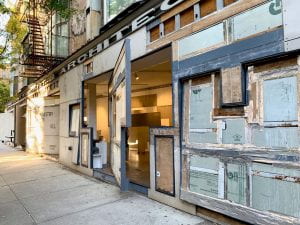
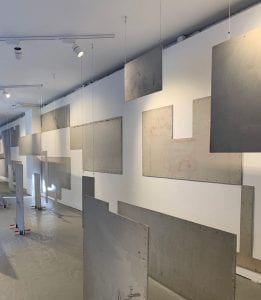
Other exiting exhibition spaces include the Storefront for Art and Architecture, that seeks to advance innovative and critical ideas that contribute to the design of cities, territories, and public life. Storefront is known for its interdisciplinary approach, providing alternative platforms for dialogue and collaboration across various disciplines, geographies and ideological boundaries. Moreover, it constantly seeks to promote emerging voices and activate the built environment.
Some of us had the opportunity to visit Storefront’s most recent exhibit, Ministry for All by Carla Juaçaba and Marcelo Cidade. The exhibit is a site-specific installation that exposed the physical characteristics of the gallery space to comment on the social and political foundations of the built environment. The installation created with Storefront’s existing infrastructural elements, undresses the gallery’s façade to acknowledge the vulnerability of architecture.
7. The MET Breuer
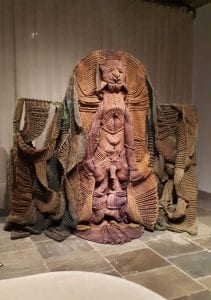
Another great museum to visit is the MET Breuer, a museum of modern and contemporary art re-imagined in an architectural icon. One of my favorite exhibits on display when I visited the museum was Mrinalini Mukherjee’s Phenomenal Nature. The work focused on the intersection between traditional craft techniques and modernism. The main material used in her works was fiber. She used an intuitive laborious process of working with her hands to create a unusual, mysterious, sexual, and, at times grotesque forms. The works as shown in the gallery commanded presence and scale, drawing attention to figures seen in Indian mythology. Other featured exhibits were Vija Clemins’ To Fix the Image in Memory and Home is a Foreign Place.
8. Mmuseumm

And lastly, one of my most favorite museums is the Mmuseumm, a tiny museum housed in a New York freight elevator that is dedicated to exploring the ‘overlooked’, ‘dismissed’ and ‘ignored’ in modern humanity and current events around the world by showcasing objects around the world. The exhibit currently on display was similar to the theme of the Whitney Biennial on history, identity, craft and community. It featured objects made by prisoners in United States Prisons, ISIS currency as well as counterfeit objects created after the collapse of Venezuela’s economic system amongst others. The objects seek to tell stories about the modern world by expanding into a network of expected and unexpected locations.
The list is obviously non-exhaustive and other must-see museum and exhibition spaces include the Guggenheim, Noguchi Museum, Queens Museum, MOMA PS1, Neue Galerie, New Museum and much more! The semester is the best time to make use of what the city has to offer to us.
